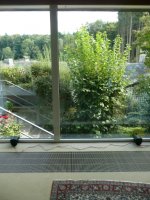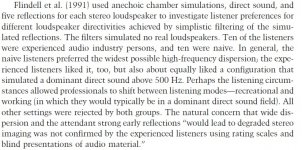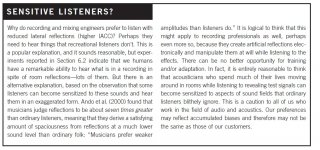the glass wall?
Frequency response and radiation pattern linearity are better than 8" Fostex FR drivers. Distortion will be higher, yes, but I did not listen at high levels. Anything else in the driver that would explain the lack of spatial precision?anyway, these are hardly HiFi speakers
Where did I claim this to be a Beveridge placement? My introduction told you that it is not. Is your "flooder" only valid in Beveridge placement?against back wall and 1.5 m from side walls?
tu put is short: this is not a flooder in Beveridge placement, isn't it obvious?
Obviously you didn't tell us all the prerequisits for a "real" flooder. Tell me more, what has to be obeyed to build a "real" flooder?this is a kind of flooder-like thing but with low-fi Cantons, apparently unsuitable for the purpose plus suboptimal positioning
Of course there is furniture, plants etc. in the room. Does the "flooder" need a special room treatment?furthermore:
just the carpet, isn't it too live?
Attachments

...
Anything else in the driver that would explain the lack of spatial precision?
I can't explain - perhaps looks like o joke = sounds like a joke? but it is no rule, Elias' cardboard stereolit with pillow also looked like a joke
Where did I claim this to be a Beveridge placement? My introduction told you that it is not. Is your "flooder" only valid in Beveridge placement?
absolutely not
I referred to Beveridge placement because it's been discussed recently in this thread, to make it clear that Your negative test doesn't apply to it
Obviously you didn't tell us all the prerequisits for a "real" flooder. Tell me more, what has to be obeyed to build a "real" flooder?
ask el'Ol, tinitus an many others, recently JamesTRexx and Kjeldsen - all of them set up their experiments more-or-less according to my suggestions and found the results promising and worthy of further development
Of course there is furniture, plants etc. in the room. Does the "flooder" need a special room treatment?
not to my knowledge, any typical room should be ok
can't explain Your results in any other way than bad luck, something wrong, I don't know what
certainly looks like a joke, perhaps herein lies an explanation - bad attitude?
A strongly comb filtered response is ugly, period. Having the reflected response be a duplicate of the direct response doesn't make it any less ugly. If you filter the summed response with a critical band approach you won't find the combination any flatter.
Actually critical band filtering does make it flatter in some cases. Are you lacking information?
Read Lipshitz and Vanderkooy ...
Read Bech ...
How about you? Would you DIY something, a stereolith concept perhaps?
The notion that "reflections are okay if they are flat" is totally unfounded.
David S.
AMEN! Thus constant directivity is not needed.
- Elias
it is interesting to note though that Elias was not initially impressed with His first stereolitic tests either
Yes, that was before I invented the direct sound blockage was mandatory for the imaging to work. Otherwise it was just a sound from a cardboad box. But after it was properly set up, there was no cardboard box anymore but instead the orchestra was spread in front of me and I could point the players in different locations, like in real life I could have done.
What can be said? Those who have tried it believe, does who have not don't believe.
- Elias
bad attitude?
LOL Rudolf, maybe the system sensed that you were not sincere, so it ceased to work


Frequency response and radiation pattern linearity are better than 8" Fostex FR drivers. Distortion will be higher, yes, but I did not listen at high levels. Anything else in the driver that would explain the lack of spatial precision?
Where did I claim this to be a Beveridge placement? My introduction told you that it is not. Is your "flooder" only valid in Beveridge placement?
Obviously you didn't tell us all the prerequisits for a "real" flooder. Tell me more, what has to be obeyed to build a "real" flooder?
Of course there is furniture, plants etc. in the room. Does the "flooder" need a special room treatment?
Hi Rudolf,
Forget about the almighty flodder. There is no documented reference design just anecdotal appraisal from a single user.
It's basically just a speaker on the floor creating colored direct sound and strong reflections from the ceiling. You'll perceive a high level of ASW but that's where the list of favorable attributes ends.
P.S. Try toeing in the speakers on the photo a little bit and angle them so they directly shoot at the first reflection point on the ceiling.
CD enables a loudspeaker to hide its distance at least in free space.
Are you not lacking some basic concepts? In free space directivity has no meaning since there is nothing else than the direct sound, it is the definition of the free space. No reflections.
Making the speakers "disappear" virtually and let only phantom sources
be there when listening to music surely has a lot more requirements.
Being omni e.g. is none of those, neither is "indirect radiaton" nor
excessive group delay.
Says the one who never tried e.g. stereolith style concept by himself.
Oliver, within all the time you have spent writing all the posts why it cannot work, you could have easily conducted an experiment to see for yourself. But no, your prejudices prevented that from happening and did not let you think outside the box. It's sad, for you.
- Elias
What happens in free space if you measure the on axis frequency
response of a common (non CD) 2 way loudspeaker at different distances ?
Entropy will increase.
Prejudices give hold and security in a world of rapidly changing views and opinions.
Trying different loudspeaker configurations hardly changes the values of life. Your opinion might change however. Do you think trying stereolith style system posses a security risk?
- Elias
Even you, and others who advocate high directivity treble toed in to cross in front of you, admit that high directivity treble is fundamentally bad, because you cannot take it directly facing you, but you need to turn it away from you, to diminish the direct sound and to emphasise reflected energy.
Cannot you all see this is approaching the same principle of how sound projecting principle works? Like stereolith style consepts.
Toe in almost 45 degrees. Turn a bit more and it'll be side ways.
The problem in your approach: Toe in front of you and the speaker illuminates the contralateral wall maximally. Why purposely amplify the sound from the wrong side? The more smart way to do is to illuminate the wall of the same side, i.e. the right channel signal illumintes the right wall, and vice versa.
- Elias
Cannot you all see this is approaching the same principle of how sound projecting principle works? Like stereolith style consepts.
Toe in almost 45 degrees. Turn a bit more and it'll be side ways.
The problem in your approach: Toe in front of you and the speaker illuminates the contralateral wall maximally. Why purposely amplify the sound from the wrong side? The more smart way to do is to illuminate the wall of the same side, i.e. the right channel signal illumintes the right wall, and vice versa.
- Elias
FWIW, the speakers that I've heard disappear the most were CD and narrow~70 degrees above 1.5Khz and cross-fired in front of me. My speakers now are considerably more broad patterned, but they are still toed in fairly tight(not all the way to 45 degrees though). Disappear well and image well. No gaps up front.
Dan
Even you, and others who advocate high directivity treble toed in to cross in front of you, admit that high directivity treble is fundamentally bad, because you cannot take it directly facing you, but you need to turn it away from you, to diminish the direct sound and to emphasise reflected energy.
Cannot you all see this is approaching the same principle of how sound projecting principle works? Like stereolith style consepts.
Toe in almost 45 degrees. Turn a bit more and it'll be side ways.
The problem in your approach: Toe in front of you and the speaker illuminates the contralateral wall maximally. Why purposely amplify the sound from the wrong side? The more smart way to do is to illuminate the wall of the same side, i.e. the right channel signal illumintes the right wall, and vice versa.
- Elias
The reason for toe-in is not "unbearable treble". 45° toe-in is an idea of Bauer ("Broadening the Area of Stereophonic Perception", JAES 8) from the 60s which helps to broaden the sweet spot. The nice side effect is a reduction in lateral energy but the room has to have a certain shape/size so the more delayed contralateral reflections isn't too prominent. That's the only downside.
Toe in achieves two things; rolled off high end, and more artificial room "reverb" that may give the music a more spacial feel, but at the expense of clarity of any embedded imaging info. Since recording techniques are usually deficient in several ways, it could be argued that whatever sounds better, is better.Even you, and others who advocate high directivity treble toed in to cross in front of you, admit that high directivity treble is fundamentally bad, because you cannot take it directly facing you, but you need to turn it away from you, to diminish the direct sound and to emphasise reflected energy.
Cannot you all see this is approaching the same principle of how sound projecting principle works? Like stereolith style consepts.
Toe in almost 45 degrees. Turn a bit more and it'll be side ways.
The problem in your approach: Toe in front of you and the speaker illuminates the contralateral wall maximally. Why purposely amplify the sound from the wrong side? The more smart way to do is to illuminate the wall of the same side, i.e. the right channel signal illumintes the right wall, and vice versa.
- Elias
Linkwitz criticized the vertical line array speaker saying that Patricia Barber sounded too much bigger than real life. Think for a minute about how her voice is recorded. A mono mic is right up against her mouth... It may sound quite different if she was instead recorded with a stereo head mic a few feet out. Perhaps the problem is how things are recorded rather than how the speakers reproduce the info.
The naive group had a strong preference for the omni settings.
More interesting is to find out reasons for this above fact, than listen narrow minded opinions of some hifi magazine editor.
The question is: Why wide directivity is strongly preferred ?
Is it as simple as sophisticated listeners prefer directional speakers and less sophisticated listeners, omnis?
David S.
Those might do for occasional listening of elevator muzak, but the most sophisticated prefer stereolith style sound projection. I listen wearing white tie, and drink XO. You believe?
- Elias
They split the listeners into a group of industry professionals and a group of "naive" listeners. The professional group was about equally split between liking the most directional extreme and the omni-directional extreme (few votes for any middle directivities). The naive group had a strong preference for the omni settings.
...
Is it as simple as sophisticated listeners prefer directional speakers and less sophisticated listeners, omnis?
less sophisticated listeners that is the naive group and half of industry professionals?

no wonder we debate ad nauseam

Flindell conclusions as quoted in Toole:
Attachments
Of course something unnatural sound alien ! Why half of the industry professionals are not able to hear that ?
It must be that the half of the industry professionals have twisted priorities, unnatural ones.
yes, this must be the case, they simply have a kind of occupational disease
that this must be the case is also an opinion of Dr Toole:
SOME LISTENERS CAN BECOME SENSITIZED TO THESE SOUNDS AND HEAR THEM IN AN EXAGERRATED FORM
Attachments
I'm not trying to argue about anything. Bauer is just the only "real" reference one can link to when talking about the idea of "toe-in".
You see Scott - in Markus' world "Bauer is real" and "JBL Paragon is not real"

I don't have a better simple idea for highly reverberant rooms.
fortunately others have
from Bob Olhsson (posted by him at gearslutz forum):
Dave Moulton did a simple demo for me in a bare room that turns most of what we thought we knew about acoustic treatment and imaging right on its ear.
He had designed some speakers that deliver a flat response across 180 degrees. The imaging in the bare room was holographic, among the best I've ever heard.
...
The problem with room tuning and early reflection absorption is that they are oversimplifications that have little to do with how we actually hear.
Moulton and Olhsson - just two examples of pro guys who don't suffer from the occupational disease - have normal hearing
of course it was not a church
but...
churches and other large highly reverberant rooms
?? are we talking churches and halls or average listening rooms?
Last edited:
I trust that was a genuine perception. There you see, a real world example that your stereo didn't work, but the sound was coming from the speakers ! Occasionally it apparently works because some sound was coming between the speakers too.
- Elias

The way I would look at the results is that when asked to vote on which sound presentation they "preferred", there was a tendency to vote ...
...
(mine)
but this is not the point! the conclusion was not just about votes on preferences
it was about whether strong early relfections lead to perceivably degraded stereo imaging
again, in "7" font size, the biggest I can use, perhaps it will help:
from those conclusions:
THE NATURAL CONCERN THAT WIDE DISPERSION AND THE ATTENDANT STRONG EARLY REFLECTIONS "WOULD LEAD TO DEGRADED STEREO IMAGING WAS NOT CONFIRMED BY THE EXPERIENCED LISTENERS USING R A T I N G S C A L E S AND BLIND PRESENTATION OF AUDIO MATERIAL."
- Status
- This old topic is closed. If you want to reopen this topic, contact a moderator using the "Report Post" button.
- Home
- Loudspeakers
- Multi-Way
- Unconventional Techniques for Achieving Oustanding Stereo Imaging




